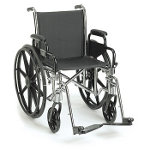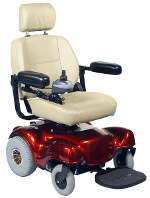The Wheelchair Guide
Your Wheelchair and Mobility Scooter Resource
Manual Wheelchairs vs Electric Wheelchairs: A Buyers Guide
Monday, January 4th, 2010 at 1:15 pm
Wheelchairs are important safety tools that are used by those who are unable to walk or have difficulty doing so. While the wheelchair has roots that date back thousands of years, modern wheelchairs are based off of a hollow steel tube design that was developed during the 1930′s. This design remains popular today and helps keep the weight of the wheelchair down, without sacrificing its strength.
While the folding steel tube manual wheelchair is still very common, many wheelchair users prefer electric wheelchairs. Electric wheelchairs offer the same basic functionality that manual wheelchairs offer, except they are operated electronically. Electric wheelchairs also have a design that is much different than a manual wheelchair is.
How Manual Wheelchairs are Designed
 A manual wheelchair usually has a wide chair, with two large wheels on either side and two small wheels in front. The larger wheels have handrails that extend off of the wheel and allow the user to move the wheels, without having to actually touch that part f the wheel that makes contact with the ground.
A manual wheelchair usually has a wide chair, with two large wheels on either side and two small wheels in front. The larger wheels have handrails that extend off of the wheel and allow the user to move the wheels, without having to actually touch that part f the wheel that makes contact with the ground.
Many manual wheelchairs also have push handles that extend backwards from the top of the chairs seat, allowing someone to push the wheelchair from behind.
While most manual wheelchairs are designed to be self-propelled, which is why they have the larger rear wheels, some wheelchairs are only designed to be pushed. These wheelchairs, which are sometimes called transfer wheelchairs or transport wheelchairs, have much smaller wheels.
Sports wheelchairs are also very popular and come in a variety of designs. Some, like those used during wheelchair basketball or wheelchair rugby, are very specialized. For example, since wheelchair basketball can be so dangerous, a wheelchair basketball sports wheelchair will have a guard around the entire wheelchair. Another example of a specialized sports wheelchair is those used for wheelchair racing, which have a much longer wheelbase than other wheelchairs.
Other sports wheelchairs offer a much less specialized design, with a focus more on being lightweight and small, while allowing for optimal turning and speed. These are a popular choice by many wheelchair users, even those who do not actually play wheelchair sports.
How Electric Wheelchairs Are Designed?
 Electric Wheelchairs, on the other hand, are not intended to be self-propelled and are instead operated using a rechargeable battery. As a result, they only have a limited range before the battery must be recharged.
Electric Wheelchairs, on the other hand, are not intended to be self-propelled and are instead operated using a rechargeable battery. As a result, they only have a limited range before the battery must be recharged.
The weight of the rider as well as what type of terrain is driven over can affect the wheelchairs per-charge range. So, for example, driving up hill will wear the battery out quicker than driving it on level ground. With that said, many have ranges that are over 8 miles per charge, which is a fairly large distance for most people.
Unlike manual wheelchairs, the wheelbase of an electric wheelchair is very small. Some have four small wheels, with the rear wheels being responsible for actually moving the wheelchair. Other power chairs use a mid-wheel drive system, with a set of wheels in the front and back that provide support, while the set of wheels in the middle are responsible for moving the chair. Usually a mid-wheel drive power chair is much more maneuverable than a rear-wheel drive power chair.
Atop of the plastic base of the power chair, a captains chair is installed. Usually the captains chair is designed similarly to an office chair. The armrests can be folded up and the actual control system is placed on either the right or left armrest. The chair can also be pivoted to make it easier to enter and exit the wheelchair.
Like office chairs, the style of the captains chair varies depending on the model of the electric wheelchair. For instance, some will have a much higher back with head and neck support, while others have a considerably lower back without any neck support.
What is Best For Me?
Often, choosing between a power chair or a manual wheelchair comes down to personal preference. For instance, many prefer the physical effort that is required to use a manual wheelchair, while others find that it is too strenuous.
Cost is also a factor, as you can usually find a quality manual wheelchair for less than $500, while an electric wheelchair usually starts at $1500 and goes up from there.
It is also important to consider where you will be using the wheelchair, as if you are only planning on using it around the home, an electric wheelchair could be overkill. On the other hand, someone going to school and traveling across campus daily might prefer an electric wheelchair.
Transporting the wheelchair is another concern. Most manual wheelchairs are designed to be folded when not in use. This allows them to be stored in the trunk of a car or even the backseat with little difficulty. Electric wheelchairs, on the other hand, are considerably heavier and will often require some sort of wheelchair lift is installed onto the automobile.
Another consideration is that a Manual Wheelchair will almost always work, providing it is regularly maintenance. An electric wheelchair is more prone to mechanical or electrical failure, as well as being more sensitive to rain and other elements. As a result, a manual wheelchair often provides a much more long term and dependable option, without the need for replacing batteries or other maintenance that is required on a power chair.